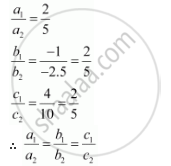Advertisements
Advertisements
प्रश्न
The planes: 2x − y + 4z = 5 and 5x − 2.5y + 10z = 6 are
(A) Perpendicular
(B) Parallel
(C) intersect y-axis
(C) passes through `(0,0,5/4)`
उत्तर
The equations of the planes are
2x − y + 4z = 5 … (1)
5x − 2.5y + 10z = 6 … (2)
It can be seen that,

Therefore, the given planes are parallel.
Hence, the correct answer is B.
APPEARS IN
संबंधित प्रश्न
In following cases, determine the direction cosines of the normal to the plane and the distance from the origin.
z = 2
In following cases, determine the direction cosines of the normal to the plane and the distance from the origin.
x + y + z = 1
In following cases, determine the direction cosines of the normal to the plane and the distance from the origin.
5y + 8 = 0
If the coordinates of the points A, B, C, D be (1, 2, 3), (4, 5, 7), (−4, 3, −6) and (2, 9, 2) respectively, then find the angle between the lines AB and CD.
Find the coordinates of the point where the line through (3, −4, −5) and (2, − 3, 1) crosses the plane 2x + y + z = 7).
Find the coordinates of the point where the line through the points (3, - 4, - 5) and (2, - 3, 1), crosses the plane determined by the points (1, 2, 3), (4, 2,- 3) and (0, 4, 3)
Find the equation of the plane passing through the point (2, 3, 1), given that the direction ratios of the normal to the plane are proportional to 5, 3, 2.
If the axes are rectangular and P is the point (2, 3, −1), find the equation of the plane through P at right angles to OP.
Reduce the equation 2x − 3y − 6z = 14 to the normal form and, hence, find the length of the perpendicular from the origin to the plane. Also, find the direction cosines of the normal to the plane.
Reduce the equation \[\vec{r} \cdot \left( \hat{i} - 2 \hat{j} + 2 \hat{k} \right) + 6 = 0\] to normal form and, hence, find the length of the perpendicular from the origin to the plane.
Write the normal form of the equation of the plane 2x − 3y + 6z + 14 = 0.
The direction ratios of the perpendicular from the origin to a plane are 12, −3, 4 and the length of the perpendicular is 5. Find the equation of the plane.
Find a unit normal vector to the plane x + 2y + 3z − 6 = 0.
Find the equation of a plane which is at a distance of \[3\sqrt{3}\] units from the origin and the normal to which is equally inclined to the coordinate axes.
Find the vector equation of the plane which is at a distance of \[\frac{6}{\sqrt{29}}\] from the origin and its normal vector from the origin is \[2 \hat{i} - 3 \hat{j} + 4 \hat{k} .\] Also, find its Cartesian form.
Find the equation of the plane passing through the points (−1, 2, 0), (2, 2, −1) and parallel to the line \[\frac{x - 1}{1} = \frac{2y + 1}{2} = \frac{z + 1}{- 1}\]
Write a vector normal to the plane \[\vec{r} = l \vec{b} + m \vec{c} .\]
Write the value of k for which the line \[\frac{x - 1}{2} = \frac{y - 1}{3} = \frac{z - 1}{k}\] is perpendicular to the normal to the plane \[\vec{r} \cdot \left( 2 \hat{i} + 3 \hat{j} + 4 \hat{k} \right) = 4 .\]
Write the vector equation of the line passing through the point (1, −2, −3) and normal to the plane \[\vec{r} \cdot \left( 2 \hat{i} + \hat{j} + 2 \hat{k} \right) = 5 .\]
Find the vector equation of a plane which is at a distance of 5 units from the origin and its normal vector is \[2 \hat{i} - 3 \hat{j} + 6 \hat{k} \] .
Find the image of the point having position vector `hat"i" + 3hat"j" + 4hat"k"` in the plane `hat"r" * (2hat"i" - hat"j" + hat"k") + 3` = 0.
The equations of x-axis in space are ______.
Find the equation of a plane which is at a distance `3sqrt(3)` units from origin and the normal to which is equally inclined to coordinate axis.
If the line drawn from the point (–2, – 1, – 3) meets a plane at right angle at the point (1, – 3, 3), find the equation of the plane.
What will be the cartesian equation of the following plane. `vecr * (hati + hatj - hatk)` = 2
In the following cases find the c9ordinates of foot of perpendicular from the origin `2x + 3y + 4z - 12` = 0
Find the vector and cartesian equations of the planes that passes through (1, 0, – 2) and the normal to the plane is `hati + hatj - hatk`
